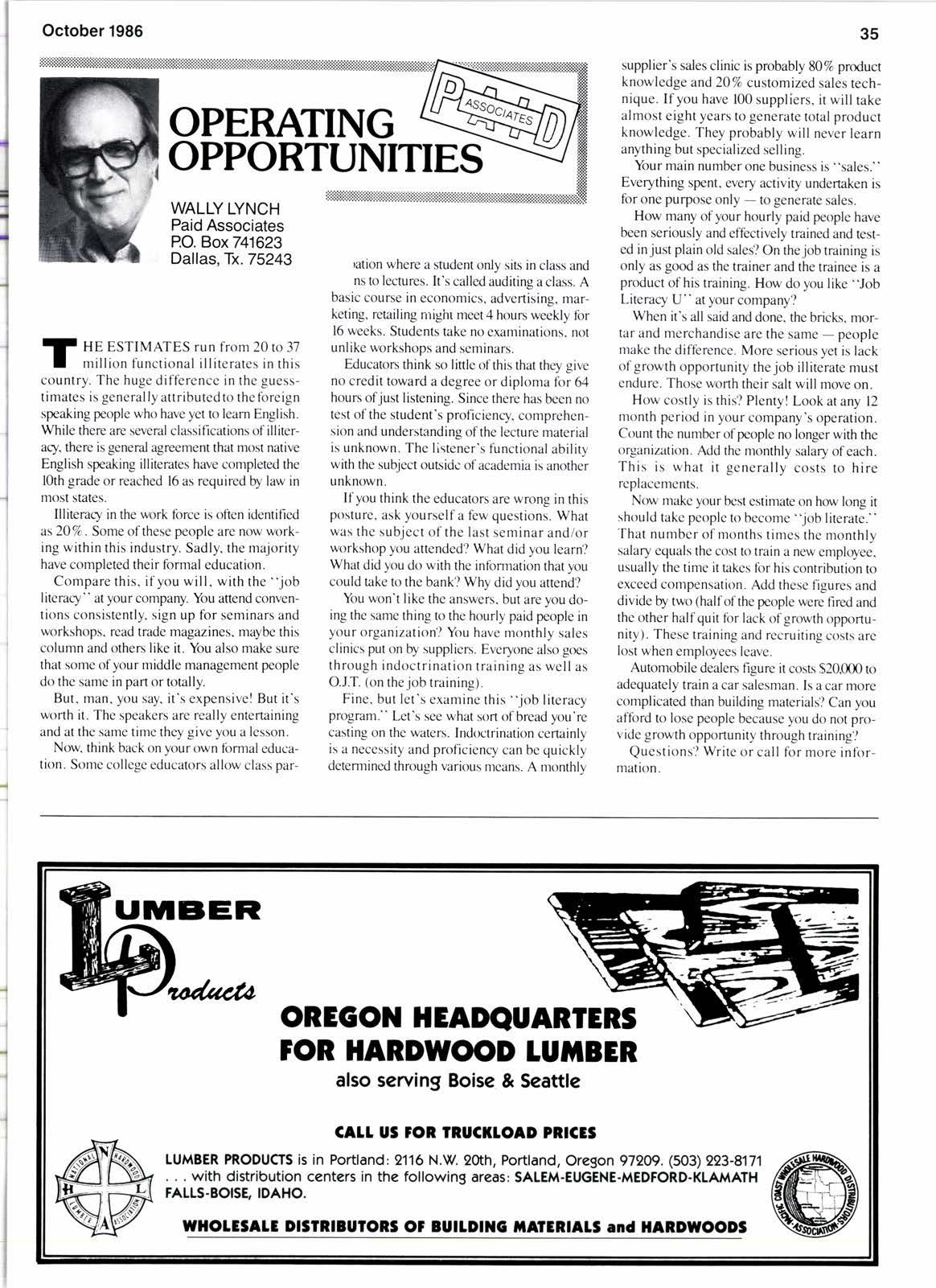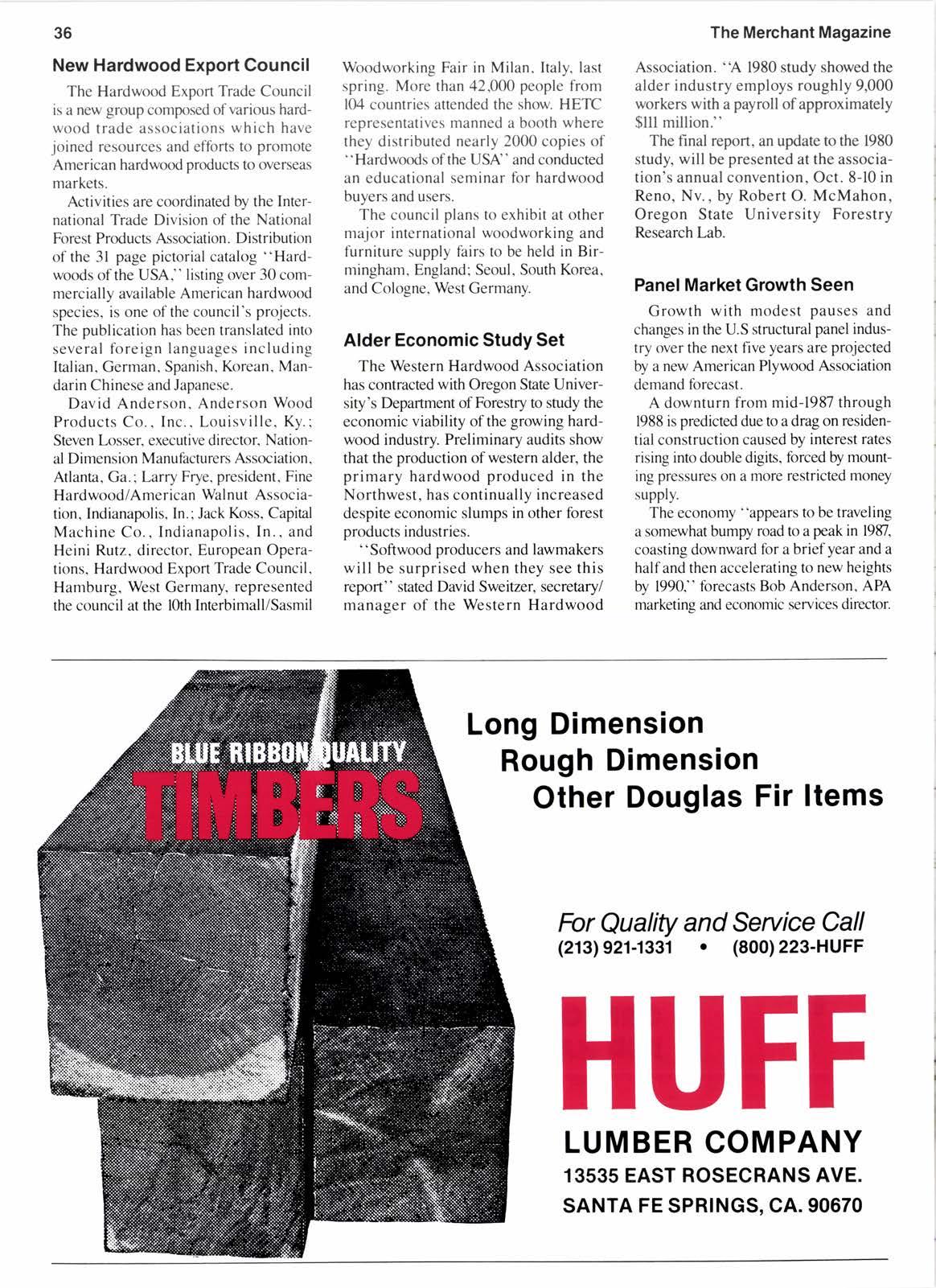
5 minute read
OPERATING OPPORTUNITIES
WALLY LYNCH Paid Associates PO. Box 741623 Dallas, Tx.75243
HE ESTIMATES run from 20 to37 million functional illiterates in this country. The huge difference in the guesstimates is generally attributed to the foreign speaking people who have yet to learn English. While there are several classilications of illiteracy, there is general agreement that most native English speaking illiterates have completed the lOth grade or reached 16 as required by law in most states.
Illiteracy in the work force is often identified as20%. Some ofthese people are now working within this industry. Sadly, the majority have completed their formal education.
Compare this, if you will, with the "job literacy" at your company. You attend conventions consistently, sign up for seminars and workshops. read trade magazines, maybe this column and others like it. You also make sure that some of your middle management people do the same in part or totally.
But, man, you say, it's expensive! But it's worth it. The speakers are really entertaining and at the same time they give you a lesson.
Now, think back on your own formal education. Some college educators allow class par-
'ation where a student only sits in class and ns to lectures. It's called auditing a class. A basic course in economics, advertising, marketing, retailing might meet 4 hourc weekly for 16 weeks. Students take no examinations. not unlike workshops and seminars.
Educaton think so little ofthis that they give no credit toward a degree or diploma for 64 hours ofjust listening. Since there has been no test ofthe student's proficiency, comprehension and understanding ofthe lecture material is unknown. The listener's functional ability with the subject outsidc of academia is another unknown.
Ifyou think the educators are wrong in this posture, ask yourself a few questions. What was the subject of the last seminar and/or workshop you attended? What did you learn? What did you do with the information that you could take to the bank? Why did you attend?
You won't like the answers, but are you doing the same thing to the hourly paid people in your organization? You have monthly sales clinics put on by supplien. Evcryone also goes through indoctrination training as well as O.J.T. (on the job training).
Fine, but let's examine this "job literacy program." Let's see what sort of bread you're casting on the wateni. Indoctrination certainly is a necessity and proficiency can be quickly determined through various mcans. A monthly supplier's sales clinic is probably 80% product knowledge and20% customized sales technique. If you have 100 suppliers, it will take almost eight years to generate total product knowledge. They probably will never learn anything but specialized selling.
Your main number one business is "sales.'' Everything spent, every activity undertaken is for one purpose onlyto generate sales.
How many of your hourly paid people have been seriously and effectively trained and tested in just plain old sales? On the job training is only as good as the trainer and the trainee is a product of his training. How do you like "Job Literacy U" at your company?
When it's all said and done, the bricks. mortar and merchandise are the same - people make the difference. More serious yet is lack of growth opportunity the job illiterate must endure. Those worth their salt will move on.
How costly is this'? Plenty! Look at any 12 month period in your company's operation. Count the number of people no longer with the organi;zation. Add the monthly salary of each. This is what it generally costs to hire replacements.
Now make your best estimate on how long it should take peoplc to become "job Iiterate."
'Ihat numbe r of months times the monthly salary equals the cost to train a new employee, usually the time it takes for his contribution to exceed compensation. Add these figures and divide by two (half of the people were fired and the other halfquit for lack ofgrowth opportunity). These training and recruiting costs arc lost when employees leave.
Automobile dealen figure it costs $20,000 to adequately train a car salesman. Is a car more complicated than building materials? Can you afford to lose people because you do not provide growth opportunity through training'?
Questions? Write or call for more information.
New Hardwood Export Council
The Hardwood Export Trade Council is a new group composed of various hardwood trade associations which have joined resources and efforts to promote American hardwood products to overseas markets.
Activities are coordinated by the International Trade Division of the National Forest Products Association. Distribution of the 3l page pictorial catalog "Hardwoods of the USA," listing over 30 commercially available American hardwood species, is one ofthe council's projects. The publication has been translated into several foreign languages including Italian, German, Spanish, Korean, Mandarin Chinese and Japanese.

David Anderson. Anderson Wood Products Co., Inc., Louisville, Ky. ; Steven Losser, executive director, National Dimension Manufacturers Association, Atlanta, Ga.; Larry Frye, president, Fine Hardwood/American Walnut Association, Indianapolis, In.; Jack Koss, Capital Machine Co., Indianapolis, In., and Heini Rutz, director, European Operations, Hardwood Export Trade Council, Hamburg, West Germany, represented the council at the lOth Interbimall/Sasmil
Woodworking Fair in Milan. Italy, last spring. More than 42,000 people from l&[ countries attended the show HETC representatives manned a booth where they distributed nearly 2000 copies of ' 'Hardwoods of the USA ' and conducted an educational seminar for hardwood buyers and users.
The council plans to exhibit at other major international woodworking and furniture supply fairs to be held in Birmingham, England; Seoul, South Korea, and Cologne, West Germany.
Alder Economic Study Set
The Western Hardwood Association has contracted with Oregon State University's Department of Forestry to study the economic viability of the growing hardwood industry. Preliminary audits show that the production ofwestern alder, the primary hardwood produced in the Northwest, has continually increased despite economic slumps in other forest products industries.
"Softwood producers and lawmakers will be surprised when they see this report" stated David Sweitzer, secretary/ manager of the Western Hardwood
Association. 'A 1980 study showed the alder industry employs roughly 9,000 workers with a payroll of approximately $lll million."
The hnal report, an update to the 1980 study, will be presented at the association's annual convention, Oct. 8-10 in Reno, Nv., by Robert O. McMahon, Oregon State University Forestry Research Lab.
Panel Market Growth Seen
Growth with modest pauses and changes in the U.S structural panel industry over the next five years are projected by a new American Plywood Association demand forecast.
A downturn from mid-1987 through 1988 is predicted due to a drag on residential construction caused by interest rates rising into double digis, forced by mounting pressures on a more restricted money supply.
The economy "appears to be traveling a somewhat bumpy road to a peak in 1987, coasting downward for a brief year and a halfand then accelerating to new heights by 199O" forecasts Bob Anderson, APA marketins and economic services director.
WBMA To Focus On Service
"llLrilrlirrr ( )rrr' \lrntr' l ltr LrLrrlt Sr'1 \ lr'.. i' tlrr' titirlt' ol the
\\c:1.'ttt IlLriltlirr.l \1lLl.rilrl .\r:or'illtion r ll]ltulrl r'{)lt\f nlion lrnti lrLrrltlin! prorlrrtts:lltrstlt:a. \Lrr. S 11.lr1 tlrr'lie,l [-iL,n Inn rrr licltlLttt't] lil!'l)r'()-:liull\ lir Irrolt':sionlrlizt blrrrnc.. rkill.. erhibit: ttl Ircrr Ptrrltttl\ lltrl \]t()\\ \l)tt ilrL:. !ii\lt rllll\\ rn-- Lntr.lt lliclrlilirt: rn. lrrtle I lrt' Irutrrre ol llrc InLiePr'nticnt lJLriltiirrl
I'lcllcr Lrt. \\lr.
Iirr': lirr J)llltlllr\!'ltt rhrrrr. illt(l \()! 1ltl r'\!'ltl\.
\llrtcrilrl I)culcr'( ontPetinl * itlt \llrr: \le r'. huntlr:e rs" br Rlir ( ()()lta\. lirtttte t ritt'ihltilnlinol thclrollrrl ol Sr'()11\'\Iltr'.. \\rnterIIlrren. l l.
.lrrrr "\lr'. \llrrit ' lJcnrlr'r'. R()lrilt\()n Ilrrrr['r'trrrtl .\::otilrlc:. I:tltltonri:. \\1r.. ri ill \llcilk ()ll flot trr'llikc ..\tlrlrrrtlr!'t'ol \irLrrI)rrtr ilrLttrrt lttttl \lltnLtllttlul'L'l' lilttl lrl.,,,'|.'11 lltr'r'()ll\alllt()n u ith (]Lritk I)rtr'h .,'llirtr trik.. ''l:ttt1llor..'lttur'rtlirt's ( iIl)l)q'r)5111jq)1t lrrrtl I)r'olll SlIrIrnl' t\ it (ll\!tt\\i()tt i-\ tltnttre tr ol tht'\rrlrn-L \\r':lctntt' ('lLth ln ultltl sofks lrltri ulltt tloa:tt l tn lltc lu.'lr. ()llt.'t 1ttr,lIlLIl: oIIrreti illc ol) l)lr'l)iu-rnl lttt tlla IutuIf \a!tll ll\ rll)rl ir\\ct J)r)l!'(11()rr rn tltt lrLrilrlirtl tnlrtt'r'ilrl lrLrrilterr. ltltti lt li,ok lrl ri ltlrt': hlr|ll;11i11.1 in \\lr:ltirtuton. I).('
Moderate '87 Growth Forecast
fl)c a(()lt()ttt\ s ill gr'()\r ir[ li Il()(lcliL[' ' (Jr; rirlc in l()fil. ton :Lrntcr'Ir'ir'c: ul) .l r(; iln\l lhc Ir'intc rlrt.' ul) il l) tll ltointlo 3t' tltt \lrtiontrl .\::ot lrtiorr ol Brrsirrtts: l.r'()n()lli\t\ l)r'atlir'l: \\lrshrrrgtort ltnlrltst' lirr.'ra.' ', lrilltcr Iiri in llt.'lr',r:: nlrlioriai ItrrtlLtit. tlte ('ottLI-t':.ir,ttlrl I:itttl:-tt Otllrt Irrr1cels.l.5tl luttl thc OIIiic ol \llrnitLrrrrcnt lrrrtl llutlg!'1. J.l',











